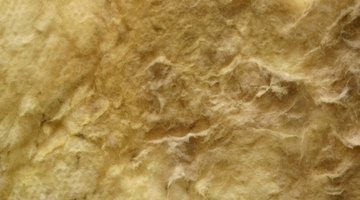The Best Thermal Insulation Materials
Thermal insulation materials offer homeowners many choices, ranging from polystyrene and polyurethane boards to wool, fiberglass and straw. Often, choosing the best material depends on the job, as some materials are more suitable for specific types of insulation than others.

Home safety is another important consideration when choosing an insulation product.
Purpose
One of the main purposes of thermal insulation is to conserve energy use and keep temperature constant. Insulation is usually understood as keeping an interior warm, but it also keeps it cooler in high temperatures. Added to this, insulation makes buildings quieter. A well-insulated home has lower energy bills and reduces use of natural resources. Thermal insulation materials can cost more initially, but the savings accrue in the long term. You should buy insulating material on the basis of its "R" value — a measure of thermal resistance. Higher R values mean the product insulates better. The most recommended materials are fiberglass, mineral wool, cellulose and polyurethane.
Fiberglass
Fiberglass is one of the best heat conservers and is still one of the most widely used insulating materials. However, because it is made of finely woven glass fibers combined with silicon and glass powder, it must be handled carefully, and anyone installing it must wear protective gear as it can damage the eyes, lungs and skin. In terms of home safety, it is not very fire resistant as the fibers melt at high temperatures. It is one of the cheapest insulating materials and its R value is between R 3.14 and R 3.8 per inch of thickness, which is good but considerably lower than the more advanced, high-tech insulation available.
Mineral Wool
Rock wool and slag wool are the two main types, but glass wool, made from recycled fiberglass is also available. Rock wool is made from basalt, while slag wool is a combination of steel mill dirt and limestone and is the most widely used type. Slag wool has several advantages. It is fire resistant and can slow down fires in the home. Also, it prevents mold and mildew growth, and it doesn't lose its insulating properties if it gets wet, unlike fiberglass. Professional installation is required, which does add to the cost. The R value is about 3.1 per inch of thickness, making it similar to fiberglass and cellulose.
Cellulose and Polyurethane
Environmentally friendly cellulose is made from recycled cardboard and paper. One home safety advantage of cellulose is that it contains hardly any oxygen, so it is highly fire resistant. Two disadvantages of this cost-effective insulating material are that some people are allergic to it, and it is not always easy to find an experienced installer. Polyurethane boards and foams have a high R value of between 3.6 and 6.5 per inch of thickness, and are also highly fire resistant.
References
Resources
Writer Bio
Based in London, Eleanor McKenzie has been writing lifestyle-related books and articles since 1998. Her articles have appeared in the "Palm Beach Times" and she is the author of numerous books published by Hamlyn U.K., including "Healing Reiki" and "Pilates System." She holds a Master of Arts in informational studies from London University.
Photo Credits
- Jupiterimages/Photos.com/Getty Images
- Jupiterimages/Photos.com/Getty Images
More Articles



